The Boruca People

THE MASKS AND BORUCA PEOPLE
You’ve probably ran into the colourful masks that seem to permeate our area – homes, shops, pubs, restaurants, and medical and real estate offices proudly display the vibrant artisan creations. But did you know that the masks are made by an indigenous tribe, the Boruca people, who live on a protected reservation in the mountains just outside Palmar? Come along as we visit the indigenous community where the Boruca people proudly craft the masks and other traditional products in numerous workshops and art shops scattered around the town. There is SO much more to the Boruca culture than the masks, and it is unfortunate most people have NO IDEA about the story and colourful traditions of these indigenous people of Costa Rica.


THE CENTRE OF THE BORUCA CULTURE
Today there are about 2,500 Boruca people most living around the town of Boruca about 32 km from Palmar, as well as in a town called Rey Curré. Both settlements are surrounded by lands that have been set aside for the tribe. Boruca is a small town but contains many amenities – a wonderful museum that tells the story of the Boruca people, a medical clinic, community hall, a local cultural radio station, pubs and restaurants, police facilities, a school and sport fields, general and food stores, a few accommodation options and MANY artesian shops where the famous masks and other crafts are made, in some cases you can see them in various state of finish. In fact, over 80% of the residents sell masks and other crafts right out of their homes! Although isolated, there is running water, electricity and cell phone service throughout the town. The locals are very open and welcoming and the town is painted in bright traditional murals creating an inviting atmosphere. Most of the Borucan people support themselves through small scale agriculture, service economy, and the crafting of the masks and other traditional Boruca objects such as naturally-dyed woven goods, bows and arrows, cow hide drums, daggers, and jewelry.
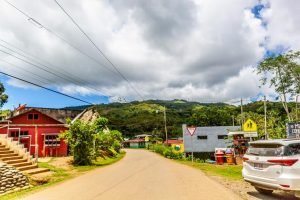



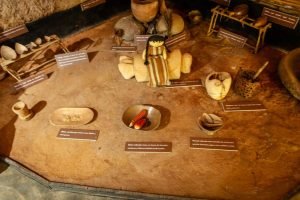
THE BORUCA PEOPLE
The Boruca people and their ancestors lived in these parts long before the Spanish conquest, first being described by the Spanish in 1562. They occupied large areas of the southern and Pacific regions of what is now Costa Rica, grouped in three main tribes: Quepoa, Turucaca and Coctú – ruling an area from what is now Quepos all the way to the current Panamanian border, including all of Osa Peninsula. It is the ancestors of these tribes who produced fine gold object and jewellery that grace many museums, as well as the stone spheres which have been found scattered around the region in great numbers. The Boruca were known to be great shipbuilders, sailing their vessels up and down the Terraba River. While their settlements were located right along the central transport route between Panama City and the colonial capital of Cartago, the inaccessibility of their land limited their early interaction with the Spaniards and thus they were able to preserve their language and much of their culture – this was also due to their brave fighting ability in holding off the Spanish incursions. The Spaniard noted the Borucas’ fortified settlements and the fact that women Boruca warriors were a formidable force. However, some Boruca people were eventually subject to hard labour under the Spanish, forced to tend fields, transport grain on their backs for very long distances, and to build canoes without any compensation for their work. Their traditional lands were slowly taken over by the newcomers. Starting in the 1930s and onwards the arrival of banana plantations and workers from around the world, the opening of the Interamerican highway, the arrival of mountain and plateau settlers, and the process of modernization put great pressure on the Boruca peoples’ traditional way of life.
The Boruca continued to sustain themselves with small-scale agricultural production and were slowly losing their cultural heritage. In the 1970s, due to the poverty of the people, local women led by Margarita Moralez came together to bring back to life the traditional arts, crafts and way of life of the Boruca. This led to the awakening of their colourful traditions, flourishing of the local economy, awareness being brought to the Boruca people and their history, and major projects being completed in the town such as the construction of the Boruca museum. It is thanks to these women that the Borucan culture is, one again, a part of the Costa Rican landscape.
THE MASKS
The wooden hand-crafted masks, typically made from balsa, come in brilliant colours and offer surreal depictions. Some are in the likeness of one or more animals like jaguars, toucans, hummingbirds, turtles, parrots, butterflies, and also include jungle plants. These are the ‘ecological’ or ‘cultural’ masks that combine both traditional and modern elements. The truly traditional masks, equally colourful, depict figures known as little devils, or ‘diablitos’. They include big fangs, horns, wide eyes and protruding tongues, and are meant to depict the ‘scary’ faces of the Boruca people as seen through the eyes of the Spanish conquistadores. The diablito masks are worn during an annual festival (Little Devils Festival) that reenacts the encounters between the Boruca and the Spaniards – each participant makes their own mask which is then discarded following the festivities.
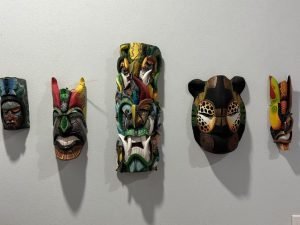
Originally the masks were not painted but the craft evolved to include natural based pigments and, today, modern paints. It can take up to four days to carve a single mask. Traditionally, the men carved the masks and the women painted them; these days a few women are active carvers of the Boruca masks.

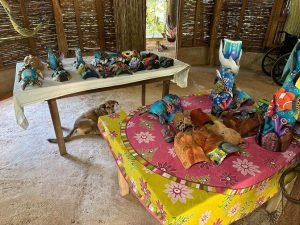

THE LITTLE DEVILS FESTIVAL
The traditional ‘scary’ masks are worn during the four-day Juego de los Diablitos de Boruca (the Games of the Boruca Little Devils), or The Little Devils Festival, an annual celebration taking place between December 30 and January 2 in Boruca, and the first week of February in Rey Curré, another nearby Boruca community. The festival is a series of dances and games in which people don the traditional Boruca devil masks (representing the Boruca people) with one person dressed as a bull (representing the Spanish conquistadores). The origins of this festival date back to at least the times of the Spanish conquests and, in 2017, the festival was declared an ‘Intangible Cultural Heritage of Costa Rica’.

The devils are organised in a hierarchy, with a boss called the ‘Greater Devil’ overseeing the action, ‘Herder Devils’ who gather the devils who stray from the games, the ‘Lesser Devils’ who are the ones to actually do battle, as well as many other devil ranks. The bull mask is the only mask which is saved for next years’ festivities – and there is only one bull. It is made from wood and natural bull horns. The atmosphere is heightened by musicians who play the flute, a traditional drum called cajon, guitar, violin and even an accordion. The days of the festival are filled with the battle between the bull and the devils retelling a story of struggle, defeat, rebirth and triumph of the Boruca people.

There are a few rules to the games, which are meant to be physical but not violent, such as a need to obey the Greater Devils and a request not to attack the foreigners (tourists).
Some researchers note that this festival could have older roots and was adjusted by the Boruca to take into account the Spaniards – this is because many artefacts showing masked figures and dancers, from before the time of the Spanish, have been recovered.
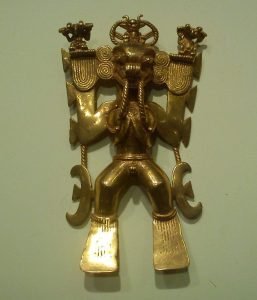
The festival is fuelled by la chicha, a fermented drink made from corn. It is an important tradition for each household to prepare la chicha and give it to the Little Devils as they visits house-to-house, being a way for the Boruca people to show their gratitude towards the devils in their fight against the Spanish, represented by the bull.
THE BORUCA LANGUAGE
The Boruca language (known as Bronka, Bronca or Brunca) is at a risk of completely disappearing – it is currently considered the most endangered of all six native Costa Rican languages. Various agencies have declared the language to be ‘critically endangered’, ‘dormant’ and even ‘extinct’. A 1992 study showed only 10 fluent (all over the age of 50) and 50 semi-fluent speakers of Brunca; a 2019 study found that no more fluent speakers remain while about 15 individuals hold a non-fluent knowledge of the language – these are thought to be teachers and young students of Brunca. Exact numbers of fluent and non-fluent speakers are unclear, but they are very low nevertheless. However, all is not lost – great efforts are being made to teach the language in Boruca elementary schools, and there is a lot of enthusiasm for revitalizing the native language and culture of the Boruca people. The Costa Rican Ministry of Culture provides grants to aid in the inclusion of Brunca in the local school curricula.
TRADITIONAL DISHES
There are a few dishes unique to the Boruca culture – while the people now regularly consume the food that is typical of the rest of Costa Rica, these special dishes ares till made and enjoyed to this day (amongst many others):
CARNE AHUMADA – Pork seasoned with onions, salt and garlic then smoked over a fire.
PALMITO – A heart of palm cut up and mixed with chili and ayote, served with salt water. Prepared for fiestas and special ceremonies.
ZAPITO – Corn and water ground with coconut, then combined with sugar and used as a topping. Served during week-long funeral ceremonies.
TAMALES – can be prepared with rice, corn, or beans mixed with salt and oil and seasoned with chili, onion, or ayote. They are served on special occasions such as birthdays or during guest visits.
CHICHA – A fermented drink made by grinding corn sprouts, adding water, sugar and yeast and then fermenting for a few days. Served on special occasions like the Little Devils Festival.
GETTING THERE
The town is called ‘Boruca’ or noted as ‘Boruca People’ on the maps. It is located about 32 km east of Palmar Norte. From Palmar Norte, take Ruta Nacional Primera 2, heading east, for about 24 kilometres. You will be following the winding Terraba River which will stay on your right, while all around you the lush, jungle covered Talamanca foothills will dominate the view in all directions. A small turn-off to the left (it is poorly marked – don’t miss it!) onto a road called Boruca will take you to a dirt/gravel path that climbs over the Talamanca hills for about 8 km. The views from the road are spectacular, you will want to make a stop or two along the way to snap a few photos (and definitely take care while driving).
As you can see there is another way to get to Boruca, from the north side.
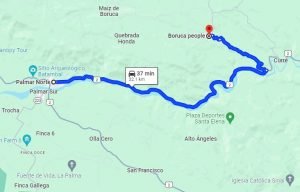

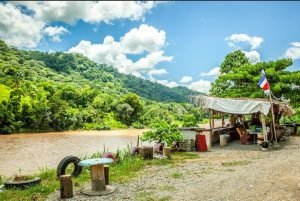
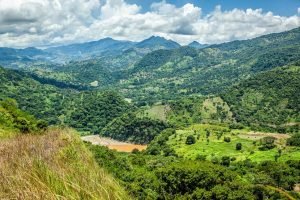
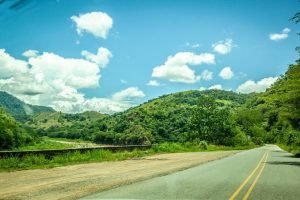
Costa Rica boasts a deep, engaging and proud culture – from its pre-Colombian roots to current customs that evolved over the past hundreds of years the traditions, music, dance, feasts and festivals are as colorful as the country’s wildlife! RE/MAX WE SELL PARADISE can help you relocate to this amazing country and as you browse our current listings – here – imagine life in such a vibrant and amazing location!



